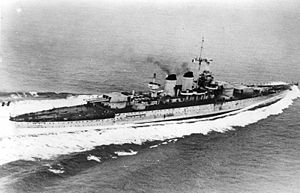Second Battle of Sirte
| Second Battle of Sirte | |||||||
|---|---|---|---|---|---|---|---|
| Part of the Battle of the Mediterranean of World War II | |||||||
 Italian battleship Littorio, Admiral Iachino's flagship |
|||||||
|
|||||||
| Belligerents | |||||||
|
|
|
||||||
| Commanders and leaders | |||||||
|
|
|
||||||
| Strength | |||||||
| 4 light cruisers 1 anti-aircraft cruiser 18 destroyers 1 submarine |
1 battleship 2 heavy cruisers 1 light cruiser 10 destroyers 1 submarine |
||||||
| Casualties and losses | |||||||
| 39 killed 3 light cruisers damaged 2 destroyers disabled 3 destroyers damaged |
No casualties 1 battleship slightly damaged |
||||||
The Second Battle of Sirte was a naval engagement in which the escorting warships of a British convoy to Malta frustrated a much more powerful Regia Marina (Italian Navy) squadron. The British convoy was composed of four merchant ships escorted by four light cruisers, one anti-aircraft cruiser, and 17 destroyers. The Italian force comprised a battleship, two heavy cruisers, one light cruiser, and eight destroyers. Despite the initial British success at warding off the Italian squadron, the battle delayed the convoy's planned arrival before dawn, which exposed it to intense air attacks that sank all four merchant ships and one of the escorting destroyers in the following days. The battle occurred on 22 March 1942, in the Mediterranean, north of the Gulf of Sidra and southeast of Malta, during the Second World War.
Malta had long been a major factor in British successes against Italian convoys to North Africa, and in return became the target of an increasing number of heavy Axis air raids. By early 1942, however, the Allies lost the initiative in the central Mediterranean as Italian and German forces gained the upper hand in their attempts to isolate Malta and even made plans to remove it as a threat. After a series of Allied setbacks changed the overall scenario, the Italians achieved naval superiority over their enemies by spring 1942. As Malta was running short of aircraft, antiaircraft guns, fuel, food and ammunition, convoy MW10 sailed from Alexandria on 21 March.
The British expected opposition from German and Italian aircraft as well as Italian surface units. In December 1941, the two battleships (Queen Elizabeth and Valiant) stationed in the eastern Mediterranean had been disabled by an attack by Italian frogmen, and so their Alexandria squadron consisted only of cruisers and destroyers. Meanwhile, a diversion was organized from Gibraltar: on the morning of 20 March, the battleship Malaya—with the aircraft carriers Eagle and Argus, supported by the cruiser Hermione and eight destroyers—set sail from "The Rock". The next day, the squadron aborted the operation and returned to port – the carriers were unable to fly off aircraft reinforcements to Malta due to defective long-range fuel tanks.
...
Wikipedia
